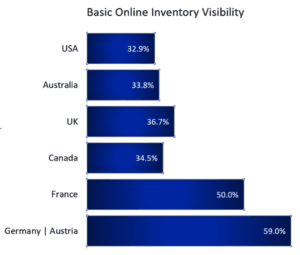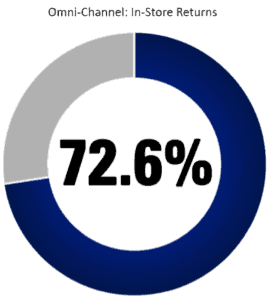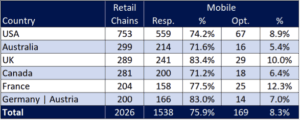
Charles Dimov, vice president of marketing, OrderDynamics
Today’s consumers push the boundaries of retail more than ever before. Shoppers’ needs and expectations continue to grow. So, on a global basis what does the retail landscape look like? Are retailers keeping up with customer expectations on key growth topics like e-commerce, omnichannel retailing, mobile commerce and social selling? Is retail really on track? What is the state of global commerce today?
Consumer Perspective
In retail, there is no doubt. Consumers hold all the cards—literally and figuratively, with a credit card in hand or stored on their phones. They are the buyer with money to spend as they navigate the web. Today’s shopper is, however, more fickle than ever, because they have options. Retail is hypercompetitive. If a customer does not like the styles, options and service of one merchant, there are many others from which to choose. All of this means it is the retailer’s job to make sure consumers like their offering and end up purchasing the merchant’s goods.
Now the question narrows: Are retailers giving customers what they seek? Be it online, physical stores or the combination of both; what is this state of global commerce? Moreimportantly, is it meeting customer demand?
Online Shopping
Online retailing is the biggest change in retail’s history. To this point, Episerver research, Reimagining Commerce: Global Findingsshows that 63 percent of consumers buy goods online at least once per month. Almost a quarter of them shop online once per week or more. Yes, online is still a small part of the overall retail picture, but it is growing fast—and has been for many years. Simply, customers like shopping online.
An interesting parallel is the OrderDynamics Omni-2000 global research. It looks at more than 2,000 retailers globally, from a shopper’s perspective. (The study looked at retailers in the following countries: United States, United Kingdom, France, Germany/Austria, Canada and Australia.) Today, 86.3 percent of retailers have an e-commerce site. Although this represents most retailers, it means almost 14 percent merely have a web presence. These merchants have no means to sell online. Definitely, a missed opportunity, on a gap that needs to be closed quickly. This is especially true as the new digital generations hold this as a core expectation with demands for ever more sophisticated shopping experiences.
Importance of Content
Consumers don’t like inaccurate or incomplete content. More importantly, they simply will not put up with it. Case in point, 64 percent of shoppers often or always abandon their online purchases, when faced with incomplete information according to the previously mentioned Episerver survey. A full 83 percent of customers use online to learn about products and services. Failing here means lost customers. Often, that is a lost shopper at the early stage of the buying journey, which means they won’t come back when they make their purchase decision.
Even when consumers casually browse online, knowing if a product is in stock counts. It’s one very important piece of the content puzzle. Yet, today only 32.9 percent of U.S. retailers provide basic inventory visibility on merchandise, as reported in OrderDynamics Omni-2000 global research. This at the overall retail level, but the picture is worse for store-level stock visibility (e.g., how many pair of jeans at a given store). Only 22.4 percent of retailers show store-level availability.
At a country level 50 percent of retailers in France and 59 percent of retailers Germany and Austria give customers good inventory visibility. On the other hand, the chart shows that English-speaking nations have some work to do.

Returns Policies
To do e-commerce well, there are several must-have features. Product searches on a robust e-commerce engine, for example, are critical. Providing clear and simple return policies are also important to shoppers. For both cases, 44 percent of shoppers abandoned their shopping cart due to the absence of this basic information according to Episerver.
 Fortunately, OrderDynamics’ global research indicates 76.9 percent of merchants provide return policies deemed to be ‘customer-friendly’. Policies need to be jargon-free, clear and use common language. In addition, 72.6 percent of omnichannel merchants also let customers return items to their physical stores. Although these are good examples, there are also the 12.4 percent of merchants that miss the mark. Surprisingly, in 12.4 percent of cases, an online returns policy could not be found. This is both an easy and important aspect to fix. Missing information about returns is like turning away customers on the front page of your website. Not a best practice.
Fortunately, OrderDynamics’ global research indicates 76.9 percent of merchants provide return policies deemed to be ‘customer-friendly’. Policies need to be jargon-free, clear and use common language. In addition, 72.6 percent of omnichannel merchants also let customers return items to their physical stores. Although these are good examples, there are also the 12.4 percent of merchants that miss the mark. Surprisingly, in 12.4 percent of cases, an online returns policy could not be found. This is both an easy and important aspect to fix. Missing information about returns is like turning away customers on the front page of your website. Not a best practice.
M-Commerce Rising
Smartphone and mobile shopping are here to stay. Over 29 percent of customers do their online shopping while browsing on a smartphone. In the U.S. 20 percent claim to make purchases on their devices daily. It is hard to dispute, when a growing number of retailers, like Starbucks, are making this the new retail with mobile payments, ordering and checkout.
Regarding mobile commerce, 75.9 percent of global retailers offer responsive sites. Of these 8.3 percent offer mobile apps or m-commerce-optimized sites. At the moment, most retailers are meeting demand with responsive websites.

The State of Global Commerce
Retail’s state of global commerce shows a few successes and a few areas for improvement. Opportunities arise from aspects like most retailers failing to show inventory visibility. Retailers with systems to support this functionality are in the prime position to gain customers. In today’s growing omnichannel retailing environment, giving shoppers options is a good thing. The merchant that makes the buying journey easy, option rich and seamless across channel—wins.
What a comparison of these two research reports highlights are the gaps and opportunities. Keys to a retailer’s success include:
- Offering good online shopping experience;
- Actively showing consumers what it available in inventory;
- Providing an easily understood returns policy;
- Letting them buy on mobile.
The state of global commerce is evolving quickly. It is about changing to match the preference of the customer. Choose the right technology partners and systems and the cards—credit and debit—will be stacked in your favor!
OrderDynamics provides omnichannel order management technology.
Favorite